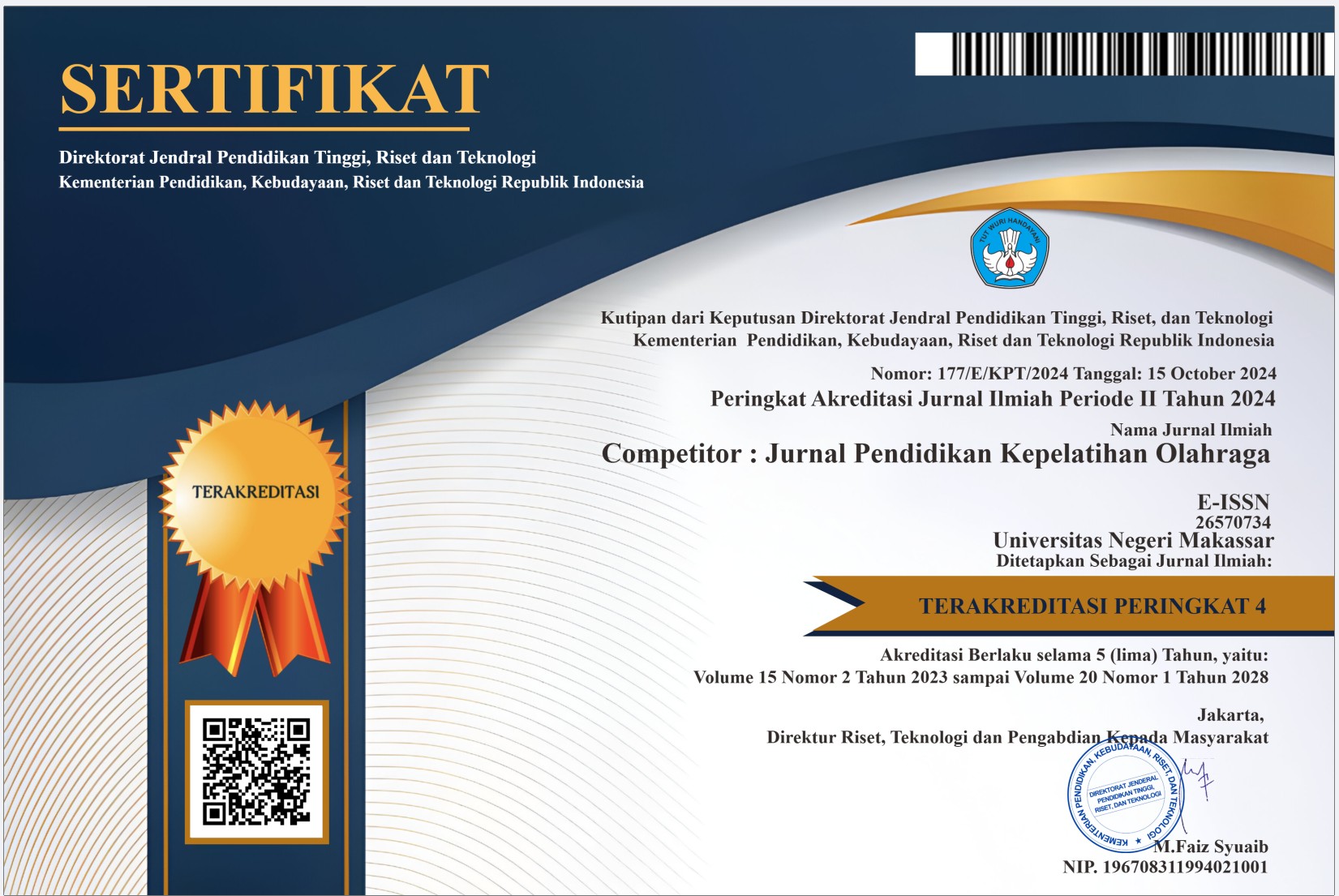Two Decades of Research on Teacher Musculoskeletal Health: A Bibliometric Analysis Using Scopus Database
DOI:
https://doi.org/10.26858/cjpko.v17i3.349Keywords:
Bibliometric Analysis, Ergonomics, Musculoskeletal Disorders, Occupational Health TeachersAbstract
Work-related musculoskeletal disorders (WMSDs) among teachers have emerged as a significant global occupational health concern. Despite growing awareness, comprehensive understanding of the research landscape remains limited. To provide a bibliometric analysis of musculoskeletal disorder research among teachers, mapping knowledge structure and identifying trends from 2000-2025. A systematic bibliometric analysis was conducted using Scopus database with search terms: ("musculoskeletal disorder*" OR "musculoskeletal pain" OR "musculoskeletal symptoms") AND ("teacher*" OR "educator*" OR "teaching profession" OR "school staff"). English-language articles from 2000 onwards were analyzed using Bibliometrix, VOSviewer, and Excel. The analysis included 129 publications generating 2,317 total citations with an average of 17.96 citations per document. Publications increased 15-fold from early 2000s to peaks of 15-17 publications in 2021-2023. Brazil led contributions (22 publications, 37%), followed by United States (12 publications, 20%) and Australia (9 publications, 15%). Five research clusters emerged: Clinical Conditions and Health Outcomes, Educational Environment and Ergonomics, Demographics and Cross-sectional Studies, Occupational Diseases and Risk Factors, and Work Conditions and Physical Demands. Research concentration during 2019-2024 represented 69% of total publications, likely influenced by pandemic impacts. This study reveals teacher musculoskeletal disorders as a rapidly expanding research domain. Geographic concentration in specific regions, limited Asian representation, and emergence of five distinct research clusters indicate both regional expertise and research gaps. The evolution from clinical-focused studies to multidisciplinary approaches incorporating ergonomic, psychosocial, and pandemic-related factors demonstrates field maturation
References
Althomali, O. W. et al. (2021) ‘Prevalence and factors associated with musculoskeletal disorders among secondary schoolteachers in Hail, Saudi Arabia: A cross-sectional survey’, International Journal of Environmental Research and Public Health. University of Ha’il, Department of Physiotherapy, Ha’il, Saudi Arabia: MDPI, 18(12). https://doi:10.3390/ijerph18126632.
Arvidsson, I. et al. (2016) ‘Cross-sectional associations between occupational factors and musculoskeletal pain in women teachers, nurses and sonographers’, BMC Musculoskeletal Disorders. Lunds Universitet, Division of Occupational and Environmental Medicine, Lund, Sweden: BioMed Central Ltd. [email protected], 17(1). https://doi:10.1186/s12891-016-0883-4.
Ceballos, A. G. da de C. and Santos, G. B. (2015) ‘Factors associated with musculoskeletal pain among teachers: Sociodemographics aspects, general health and well-being at work’, Revista Brasileira de Epidemiologia. Universidade Federal de Pernambuco, Recife, Brazil: Assocaicao Brasileira de Pos, Gradacao em Saude Coletiva, 18(3), pp. 702–715. https://doi:10.1590/1980-5497201500030015.
Cosh, K., Ramingwong, S. and Ramingwong, L. (2024) ‘A bibliometric analysis of Library Review trends’, Global Knowledge, Memory and Communication, 73(4–5), pp. 650–661. https://doi:10.1108/GKMC-06-2022-0149.
da Cruz Teles, F. et al. (2024) ‘Work-related musculoskeletal symptoms among public municipal elementary school teachers in Cuiabá, Brazil’, Revista Brasileira de Medicina do Trabalho. Universidade Federal de Mato Grosso, Cuiaba, Brazil: Associacao Nacional de Medicina do Trabalho, 22(3). https://doi:10.47626/1679-4435-2023-1131.
da Silva Vitor, J. et al. (2017) ‘Musculoskeletal Pain and Occupational Variables in Teachers With Voice Disorders and in Those With Healthy Voices—A Pilot Study’, Journal of Voice. Universidade de São Paulo, Sao Paulo, Brazil: Mosby Inc. [email protected], 31(4), pp. 518.e7-518.e13. https://doi:10.1016/j.jvoice.2016.12.021.
Csima, M. et al. (2024) ‘Downside of Helping Professions: A Comparative Study of Health Indicators and Health Behaviour among Nurses and Early Childhood Educators’, Healthcare (Switzerland). Hungarian University of Agriculture and Life Sciences, Institute of Education, Godollo, Hungary: Multidisciplinary Digital Publishing Institute (MDPI), 12(8). https://doi:10.3390/healthcare12080863.
Grabara, M. (2023) ‘The association between physical activity and musculoskeletal disorders—a cross-sectional study of teachers’, PeerJ. Akademia Wychowania Fizycznego im. Jerzego Kukuczki w Katowicach, Katowice, Poland: PeerJ Inc., 11. https://doi:10.7717/peerj.14872.
Hawk, C. et al. (2020) ‘Best practices for chiropractic management of patients with chronic musculoskeletal pain: A clinical practice guideline’, Journal of Alternative and Complementary Medicine. Texas Chiropractic College, Pasadena, United States: Mary Ann Liebert Inc., 26(10), pp. 884–901. https://doi:10.1089/acm.2020.0181.
Jakobsen, M. D., Vinstrup, J. and Andersen, L. L. (2022) ‘Factors associated with high physical exertion during healthcare work: Cross-sectional study among healthcare workers’, Work. National Research Centre for the Working Environment, Lersø Parkalle 105, Copenhagen, Denmark: IOS Press BV, 71(4), pp. 881–888. https://doi:10.3233/WOR-213647.
Kebede, A. et al. (2019) ‘Low Back Pain and Associated Factors among Primary School Teachers in Mekele City, North Ethiopia: A Cross-Sectional Study’, Occupational Therapy International. Mekele City Health Office, Mekele, Ethiopia: Hindawi Limited, 2019. https://doi:10.1155/2019/3862946.
Lazarides, M. K., Lazaridou, I. Z. and Papanas, N. (2023) ‘Bibliometric Analysis: Bridging Informatics With Science’, International Journal of Lower Extremity Wounds, pp. 15347346231153538–15347346231153538. https://doi:10.1177/15347346231153538.
Logan, D. E. et al. (2023) ‘Centering Patient and Clinician Voices in Developing Tools to Address Pain Related School Impairment: A Phase I Study of a Virtual Reality School Simulation for Children and Adolescents with Chronic Pain’, Children. Harvard Medical School, Department of Psychiatry, Boston, United States: Multidisciplinary Digital Publishing Institute (MDPI), 10(10). https://doi:10.3390/children10101644.
Mansoor, S. N., Al Arabia, D. H. and Rathore, F. A. (2022) ‘Ergonomics and musculoskeletal disorders among health care professionals: Prevention is better than cure’, Journal of the Pakistan Medical Association. Department of Rehabilitation Medicine, CMH, Okara, Pakistan: Pakistan Medical Association, 72(6), pp. 1243–1245. https://doi:10.47391/JPMA.22-76.
Matei, R. and Ginsborg, J. (2020) ‘Physical Activity, Sedentary Behavior, Anxiety, and Pain Among Musicians in the United Kingdom’, Frontiers in Psychology. Birkbeck, University of London, Centre for Sustainable Working Life, London, United Kingdom: Frontiers Media S.A., 11. https://doi:10.3389/fpsyg.2020.560026.
Mongkonkansai, J. et al. (2024) ‘Exploring musculoskeletal discomfort and school bag loads among Thai primary school students: a school-based cross-sectional survey’, Scientific Reports. Walailak University, College of Graduate Studies, Tha Sala, Thailand: Nature Research, 14(1). https://doi:10.1038/s41598-024-81545-1.
Montoya Grisales, N. E. and González Palacio, E. V. (2022) ‘Musculoskeletal disorders, stress, and life quality in professors of Servicio Nacional de Aprendizaje’, Revista de Investigacion e Innovacion en Ciencias de la Salud. Universidad de san Buenaventura, Bogota, Faculty of Education, Bogota, Colombia: Fundacion Universitaria Maria Cano, 4(2), pp. 5–19. https://doi:10.46634/riics.138.
Othman, M. and Basnan, N. (2021) ‘Assessing The Trend Of The Research On Integrated Reporting : A Bibliometric Review’, Journal of Management Information and Decision Sciences, 24(1), pp. 1–18.
Pirnes, K. P. et al. (2020) ‘Associations of neck and shoulder pain with objectively measured physical activity and sedentary time among school-aged children’, Scandinavian Journal of Pain. Faculty of Sport and Health Sciences, Jyvaskyla, Finland: De Gruyter Open Ltd, 20(4), pp. 821–827. https://doi:10.1515/sjpain-2020-0038.
Serra, G. et al. (2021) ‘Smartphone use and addiction during the coronavirus disease 2019 (COVID-19) pandemic: cohort study on 184 Italian children and adolescents’, Italian Journal of Pediatrics. Università degli Studi di Palermo, Department of Health Promotion, Palermo, Italy: BioMed Central Ltd, 47(1). https://doi:10.1186/s13052-021-01102-8.
Solis-Soto, M. T. et al. (2017) ‘Prevalence of musculoskeletal disorders among school teachers from urban and rural areas in Chuquisaca, Bolivia: A cross-sectional study’, BMC Musculoskeletal Disorders. BioMed Central Ltd., 18(1). https://doi:10.1186/s12891-017-1785-9.
Springer, S., Gleicher, H. and Hababou, H. (2018) ‘Attitudes and beliefs about musculoskeletal pain and its association with pain neuroscience knowledge among physiotherapy students in Israel’, Israel Journal of Health Policy Research. Ariel University, Department of Physical Therapy, Ariel, Israel: BioMed Central Ltd. [email protected], 7(1). https://doi:10.1186/s13584-018-0266-4.
Stochkendahl, M. J. et al. (2019) ‘Managing sickness absence of patients with musculoskeletal pain - a cross-sectional survey of Scandinavian chiropractors’, Chiropractic and Manual Therapies. Nordisk Institut for Kiropraktik og Klinisk Biomekanik, Odense, Denmark: BioMed Central Ltd. [email protected], 27(1). https://doi:10.1186/s12998-018-0230-y.
Tami, A. M. et al. (2021) ‘Epidemiology of musculoskeletal disorders among the teaching staff of the university of douala, cameroon: Association with physical activity practice’, International Journal of Environmental Research and Public Health. University of Douala, Physiology and Medicine of Physical Activities and Sports Unit, Douala, Cameroon: MDPI, 18(11). https://doi:10.3390/ijerph18116004.
Wanke, E. M. et al. (2021) ‘Determinants of pain intensity in physical education teachers focusing on dance teachers: A cross-sectional study’, International Journal of Environmental Research and Public Health. Goethe-Universität Frankfurt am Main, Social Medicine and Environmental Medicine, Frankfurt am Main, Germany: MDPI AG, 18(4), pp. 1–13. https://doi:10.3390/ijerph18042193.
Xu, X. et al. (2021) ‘Non-steroidal Anti-inflammatory Drug Use and Risk of Age-Related Macular Degeneration in the California Teachers Study’, Drugs and Aging. David Geffen School of Medicine at UCLA, Los Angeles, United States: Adis, 38(9), pp. 817–828. https://doi:10.1007/s40266-021-00885-z.
Yang, Q. and Mibu, C. (2025) ‘Physical health conditions and occupational risks among piano students and teachers in Chengdu, China: prevalence, awareness, and prevention strategies’, Critical Public Health. Sichuan Normal University, Chengdu, China: Routledge, 35(1). https://doi:10.1080/09581596.2025.2507227.
Zamri, E. N., Moy, F. M. and Hoe, V. C. W. (2017) ‘Association of psychological distress and work psychosocial factors with self-reported musculoskeletal pain among secondary school teachers in Malaysia’, PLoS ONE. Universiti Malaya, Department of Social and Preventive Medicine, Kuala Lumpur, Malaysia: Public Library of Science [email protected], 12(2). https://doi:10.1371/journal.pone.0172195.
Downloads
Published
Issue
Section
License
Copyright (c) 2025 Bayu Yoni Setyo Nugroho, Indri Astuti Purwanti (Author)

This work is licensed under a Creative Commons Attribution 4.0 International License.





















